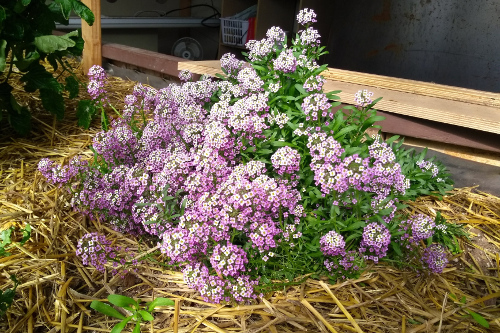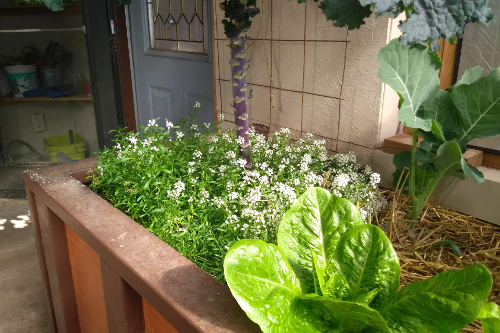COMPANION PLANTING
There is a plethora of information about companion planting available from many garden resources. Companions can improve plant growth by providing nutrients, attracting beneficial insects, repelling pests, or acting as a trap plant (attracting bugs away from your favorite vegetables). It also provides beauty and variety throughout the garden.
I use companion planting all around my garden. Some of my most common combinations are; peas & carrots, beets & beans, squash & marigolds. One of my favorite companions used all around the garden is sweet alyssum: it attracts hoverflies which eat aphids, bees to pollinate squash. It adds ground cover, keeping the soil moist. One small area of root growth provides this spreading plant underneath other larger plants. I grow it in the greenhouse year-round, and outdoors in the summer. This plant grows slowly at first: in order to get good, flowering growth earlier in the season, I start some of these in the greenhouse in mid to late winter for transplanting outdoors as soon as possible.
SWEET ALYSSUM …. shown here in the greenhouse.
BEST LIST OF COMPANIONS
Of all the resources providing lists of companion plants, several years ago I found a list of companion planting from Golden Harvest Organics. This is the most extensive & helpful list I’ve seen. It details what can & cannot be grown together, and in many cases it also gives the reasons, which I find helpful when deciding what to plant where. That website is no longer active and I cannot provide a link to the list. I have taken the liberty of providing it here. Feel free to keep this list as a good reference for companion planting. Keep in mind, this list was not made for specific climate areas, and many of these plants may not grow at high elevation.
I find it helpful to re-read this list a couple of times a year to refresh my memory and discover new companions I might try.



